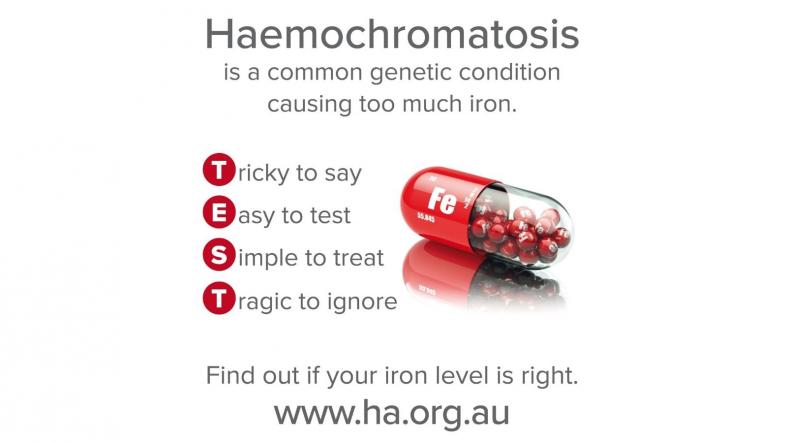If undetected and untreated, haemochromatosis leads to a number of chronic conditions including osteoarthritis, heart disease, and severe liver consequences including cancer (Pilling et al 2019). As many as 1 in 10 (C282Y homozygote) males with undetected and untreated haemochromatosis over their lifetimes, will end up with severe liver disease (Grosse et al, 2017; Atkins et al. 2020).
Tests are simple and cascade screening is recommended for first degree relatives of those already diagnosed. Research by (Adris et al 2018) shows that standard erythrocyte tests where Mean Cell Volume (MCV) and Mean Haemoglobin Volune (MHV) are both elevated may be an early indicator that a patient may have haemochromatosis. Treatment is easy and generally available through LifeBlood’s Therapeutic Donor program. Referrals for therapeutic donors are done online via LifeBlood’s High Ferritin app, which can be accessed online: https://highferritin.transfusion.com.au.
Haemochromatosis Australia (HA) is the peak body, providing support for and representing the interests of Australians with hereditary haemochromatosis. HA also provides a range of resources for health professionals on its website including links to the very popular and informative podcast series IronMatters.
HA, working with Australian Primary Health Care Nurses Association (APNA), have developed an accredited online module 'Haemochromatosis for Nurses'. HA, working with Reed Medical, have developed free online CPD learning modules accredited for CPD by RACGP and ACRRM 'Haemochromatosis: Preventing harm caused by iron overload with timely diagnosis and best practice management', which is available on the ThinkGP platform: https://www.thinkgp.com.au/education/haemochromatosis-preventing-harm-caused-iron-overload
HA’s credibility as a trusted source of evidenced-based information is underpinned by the exceptional reputations of the eminent members of their medical and scientific advisory panel.
Early detection and intervention is the key to achieving HA’s mission to ensure that no Australian suffers harm from absorbing and storing too much iron. This World Haemochromatosis Week June 1-7 HA encourage you to keep in mind the TEST for Haemochromatosis message Tricky to say, East to test, Simple to treat, Tragic to ignore.
In line with World Haemochromatosis Week, HA is promoting their IronMatters podcasts; a series of podcasts by doctors for doctors, ready for accessing online: https://haemochromatosis.org.au/iron-matters/
For more information, visit the Haemochromatosis Australia website: www.ha.org.au.
References
Adris et al. 2018 Detection of HFE Haemochromatosis in the clinic and community using standard erythrocyte tests Blood Cells, Molecules and Diseases.
Atkins et al. 2020 Association of Hemochromatosis HFE p.C282Y Homozygosity With Hepatic Malignancy JAMA
Grosse et al. 2018 Clinical penetrance in hereditary hemochromatosis: estimates of the cumulative incidence of severe liver disease among HFE C282Y homozygotes Genetics in Medicine
Pilling et al. 2019 Common conditions associated with hereditary haemochromatosis genetic variants: cohort study in UK Biobank BMJ



